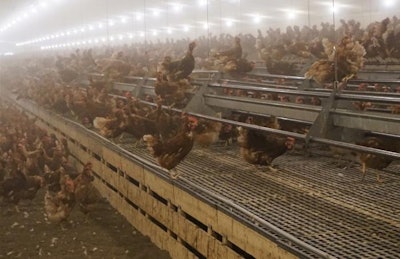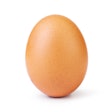
Cage-free farming brings inherent air quality challenges, so farmers need to adapt in order to protect the health of their flock and their workers.
On April 20, Dr. Hongwei Xin, director of the Egg Industry Center, spoke about the results of research surrounding devices and methods designed to mitigate airborne pollution inside cage-free layer houses and emissions coming from them. Xin, a distinguished professor at Iowa State University’s College of Agriculture and Life Sciences, spoke as part of the Egg Industry Center Issues Forum in Columbus, Ohio.
Roots of the issue
As the U.S. egg industry rapidly shifts from conventional cages and enriched cages to cage-free operations, more bird activity inside the house is leading to increased airborne pollutants like dust and ammonia. Simply, Xin said, birds are moving around in litter areas – scratching, foraging and dustbathing – as well as flapping around the house stirring up dust. The hen’s freedom to move, and evacuate waste, wherever she pleases is another challenge. This means the manure belts in houses are no longer as effective as they once were in collecting and drying waste to simplify disposal and reduce ammonia emissions.
That raises the question of how farmers can mitigate dust and ammonia levels that can harm the workers and the birds. The issue, he said, should be examined in the sense of indoor air quality – which affects hens and farm workers, and emissions from the house – which can raise issues with pollution and its impact on the environment and local ecosystems.

Dr. Hongwei Xin speaks at the opening of the 2017 Egg Industry Center Issues Forum in Columbus, Ohio. | Austin Alonzo
Reducing ammonia through feeding and management
Xin said changing what the bird eats can affect the amount of ammonia present in the house. He covered the results of studies showing the efficacy of the following methods:
- Reducing dietary protein: By reducing dietary proteins by about one percent and maintaining nutritional balance in the feed, farmers can reduce ammonia emissions by about 10 percent. Dietary fibers reduce the pH value of manure, meaning less ammonia is mobilized from the manure.
- Adding dietary fibers: Adding fiber, like wheat middling and soy hull, can reduce emissions from layer manure between 40 and 45 percent.
- Adding supplements: DDGS, or distiller’s dried grains with solubles, and EcoCal, a proprietary feed additive designed to control ammonia emissions, can work as well. A study with a 10 percent DDGS feed mixture dropped ammonia emissions by 14 percent and a 7 percent EcoCal mixture reduced ammonia by 39 percent.
Beyond feeding, drying manure on the belts is important to reduce the level of ammonia in the air. This can be done with air circulating over the belts, but that comes at the cost of about $120 per day for a 200,000-bird layer barn. He said using the exhaust air to dry manure may be a cheaper way to provide the needed airflow.
Along with manure, litter moisture must be kept in check as well to keep ammonia levels down. This is a potential double-edged sword, however, because drier litter creates more dust. Nevertheless, Xin said wet litter gives off ammonia and cakes, creating numerous health issues for the birds. Ideally, the litter moisture content should be below 20 or 30 percent to keep ammonia levels in check. A scraper can be used to keep litter from getting too deep – and becoming an invitation for floor eggs. Consistent airflow in the house is essential to keeping litter dry, too.
Devices for controlling dust and ammonia
Xin profiled a number of devices and methods to mitigate dust and ammonia. The techniques and technologies come with varying cost and effectiveness. Some are not economically viable for egg farming. For indoor air pollution mitigation, fixed electrolyzed water spray is the most effective on a cost basis, reducing dust levels by 50 percent for the cost of 10 cents per bird per year. For exhaust pollution mitigation, an electrostatic precipitator is the cheapest option.
Indoor pollutant mitigation
- Sprays: Several sprays are on the market that use a similar strategy of spraying a liquid, either a water or oil, directly onto the litter in order to reduce dust levels. The major drawback to all sprayer systems, Xin said, is the limitation of how much area a sprayer can cover and the fact that more moisture leads to wet litter, which can lead to health problems with the birds. Liquids can have modified pH levels to modify their effectiveness in controlling ammonia – because pH plays a role in converting ammonium to ammonia – and a low pH liquid can be corrosive to layer equipment. Neutralized electrolyzed water, to control ammonia emission, combined with a litter additive, to control moisture, may be the best spraying strategy for controlling dust and ammonia.
- Electrostatic options: Two types of electrostatic devices – like an electrostatic air ionizer, electrostatic space charge system and electrostatic precipitator, work by attracting dust particles to the surface of the devices either to control indoor air quality or emissions. Xin recommended using these devices inside the house in order to reduce emissions and improve the air quality for the birds and the workers. The devices can reduce exhaust from cage-free houses by between 45 and 50 percent.
- Dry filters: Dry air filters, like the kind found in a household HVAC system, can be effective in filtering the air inside a house as air is pumped through the filer. Studies show a dust reduction ability of about 40 percent.
Exhaust pollutant mitigation
- Bio-Curtain: Xin explained a Bio-Curtain is a sort of canvas cover placed over the exhaust fan used by some hog and broiler farmers to control emissions. The curtain catches the dust and other emissions and can be used with an electrostatic system. It’s a relatively low-cost option that can reduce dust emissions by about 40 percent and ammonia by about 10 percent.
- Vegetative buffer: Planting trees, shrubs and bushes around a layer house is a popular strategy in the Midwest and Southeast, Xin said, for controlling dust and ammonia emissions from layer houses. Vegetation can help with both problems, but not the smell. However, the "out of sight, out of mind" principle seems to work for vegetation and chicken house odors. The cost of installing vegetation is low as well.
- Wet scrubbers: The most sophisticated, and likely expensive option, is using one- or three-stage wet scrubbers to clean exhaust before it is expelled from the chicken house. A single-stage scrubber – where air is forced through a solution to clean it – can reduce dust emissions by about 40 percent and ammonia by about 80 percent. A three-stage scrubber, with separate phases to take out the dust, the ammonia and the odor, can reduce dust emissions by more than 70 percent and ammonia by 95 percent, but it is far more expensive than a single-stage scrubber. Both options, Xin said, are prohibitively expensive without some kind of subsidy to offset the cost of the technology and its operation.
Comprehensive resource for cage-free eggs available
A new collection of exclusive articles, blogs and infographics on Cage-free Eggs and Consumer Trust in the Poultry Industry, written by trusted WATT Global Media editors and industry experts will equip egg producers and marketers with information to help them make critical business decisions. Purchase your copy.


















